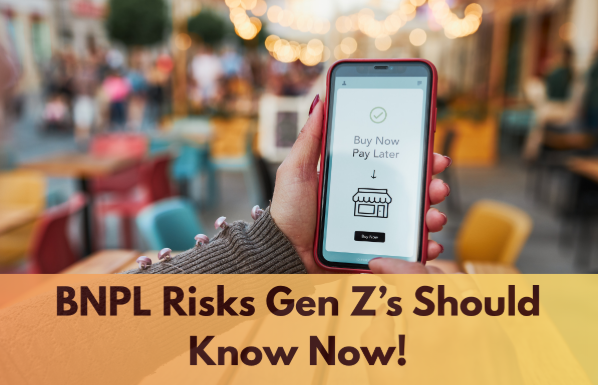Introduction: The Illusion of Easy Credit
Swipe away, tap and proceed. All it takes these days to walk out of an online store with a new outfit, gadget or flight, all without paying, due to the Buy Now Pay Later (BNPL) booming trend. At least one in every three members of Gen Z perceives BNPL as the tool of instant gratification without upfront payment.
Yet, at the back of convenience is an increasing issue: the dangers of BNPL that can cripple young consumers in an endless cycle of severe debt and the harm of credit.
This post will demystify the reality of BNPL and point out its hidden pitfalls, along with information that Gen Z will need to make better borrowing decisions.
What Is BNPL and Why Is Gen Z Hooked?
BNPL, short for Buy Now, Pay Later, is a modern payment model that allows consumers to split purchases into smaller installments, often interest-free for a limited period.
Popular BNPL platforms in India and globally include:
- ZestMoney
- Simpl
- LazyPay
- Amazon Pay Later
- Afterpay
- Klarna
- Sezzle
For Gen Z (born between 1997–2012), raised in the era of one-click convenience and app-based financial tools, BNPL feels intuitive and empowering. It’s also often marketed as “not a loan,” making it appear risk-free.
But here’s the catch: it is still credit, and it comes with consequences.
The Rise of BNPL: Convenience with a Catch
BNPL exploded during the pandemic-era e-commerce boom and continues to rise. As of 2024, India is projected to have over 100 million BNPL users.
Here’s why Gen Z loves it:
- No upfront cost – You don’t need cash to buy what you want now.
- Instant approval – No paperwork or CIBIL score checks in most cases.
- Low-friction spending – Just one tap, no need to input card details.
- Perceived as safer than credit cards – No annual fees or complex billing cycles.
But this frictionless spending leads to a big problem: you often don’t realize how much you’re spending—or how quickly debt adds up.
BNPL Risks You Can’t Afford to Ignore
1. Invisible Debt Accumulation
Using BNPL, you will not have to pay immediately, which means that your bank account will not be updated immediately. This will allow accumulating numerous loans on various platforms.
They tend to be owed Rs. 5000 here, Rs. 2000 there, and then they notice a Rs. 30,000 pile of BNPL debts without even realizing it.
BNPL makes it easy to borrow, but hard to track how much you owe.
2. Impact on Your Credit Score
Unlike what many people think, BNPL has the capacity to impact your credit. Various service providers now report such credit bureaus as CIBIL or Experian.
Late payments, even by a few days, can:
- Lower your credit score
- Affect your chances of getting future loans
- Raise interest rates on personal or education loans
Gen Z is particularly risky, and they are barely getting into their financial footprint.
BNPL credit score impact is real—especially if you miss even one EMI.
3. High Late Payment Penalties
The majority of BNPL platforms do not even impose interest-until you fail to pay on time. When that becomes the case, the fines are enormous.
Interest rates, late fees and bounce charges may make a Rs. 2,000 purchase end up as a Rs. 3,000 debt in just a few weeks.
4. No Regulation = Limited Protection
Unlike banks or credit cards, BNPL platforms are not tightly regulated. If you face issues like double billing, fraud, or hidden charges, your legal recourse is limited.
BNPL isn’t covered by the same consumer protections that credit cards or bank loans are.
5. Psychological Overspending
The ease of BNPL removes the friction of spending real money. Behavioral economists warn that people spend 30–40% more when using BNPL compared to cash or debit.
This can derail savings goals, especially when combined with FOMO and influencer-driven e-commerce trends.
Real-World Case Study: How BNPL Debt Spiraled for One Student
Ritika, 22, a college student from Bengaluru, used BNPL to buy clothes and electronics, always planning to repay “next month.” Within six months, she had:
- ₹52,000 in dues across 4 platforms
- Missed two payments due to confusion over dates
- A reduced CIBIL score from 730 to 645
This impacted her ability to get an education loan abroad and added stress during final exams. Ritika’s story isn’t rare—it’s becoming increasingly common among urban Gen Z users.
Who’s Most at Risk?
BNPL risks are particularly high for:
- Students and first-time earners
- Young professionals with irregular income
- People without strong financial literacy
- Impulse spenders on fashion, gadgets, and travel
BNPL vs Credit Cards: Which Is Riskier?
| Feature | BNPL | Credit Card |
| Approval | Easier | Harder (credit check) |
| Credit Reporting | Varies by provider | Always reported |
| Regulation | Limited | Heavily regulated |
| Interest | Often 0% (short term) | 30–40% annually |
| Late Penalties | High fees | High interest |
| Consumer Protections | Weak | Strong (disputes, fraud) |
While both tools can be misused, BNPL hides its risks better—making it more dangerous for inexperienced users.
Smart Ways Gen Z Can Use BNPL (If You Must)
If you absolutely need to use BNPL, follow these safety tips:
Use One Platform Only
Avoid juggling multiple loans across providers. Stick to one trusted platform with transparent terms.
Set Auto-Reminders
BNPL platforms don’t always send alerts. Set calendar reminders for repayment dates.
Link to Debit, Not Credit
Pay from your own funds, not another borrowed source.
Avoid EMI for Low-Cost Items
Don’t split payments for ₹500–₹1000 items. If you can’t pay cash, you probably shouldn’t buy it now.
Check Your Credit Report
Make it a habit to check your credit score every quarter. Tools like CIBIL and Experian allow free annual reports.
Future of BNPL in India: Growing but Risky
The RBI has taken steps to regulate BNPL providers more stringently. New guidelines require:
- Clear disclosures of fees and penalties
- Mandatory reporting of credit to bureaus
- Stronger KYC and fraud prevention mechanisms
Still, the responsibility lies with users—especially Gen Z—to understand the buy now pay later risks before diving in.
Final Thoughts: Knowledge Is Power
BNPL isn’t evil—but it’s easy to misuse. And when it comes to Gen Z, who are still building financial discipline and credit history, BNPL risks can turn a convenience into a credit catastrophe.
Before you hit “Buy Now, Pay Later,” ask yourself:
- Do I need this right now?
- Can I afford to pay it off on time?
- What happens if I can’t?
In the long run, a little financial caution now can mean a lot more freedom—and fewer regrets—later.
FAQs
1. Is BNPL a type of loan?
Yes. While it may not look like a traditional loan, BNPL involves credit and must be repaid within a time frame. Failure to do so results in penalties, just like with any loan.
2. Does BNPL affect your credit score?
Yes, especially if the provider reports to credit bureaus. Missed or delayed payments can lower your credit score.
3. Can BNPL help build my credit history?
In some cases, timely BNPL payments can contribute to a positive credit history. But this depends on whether the platform reports to bureaus.
4. What happens if I miss a BNPL payment?
You may face late fees, interest, and potentially a negative mark on your credit score.
5. How can I get out of BNPL debt?
Start by listing all your BNPL obligations, prioritizing high-fee ones, and paying off as much as you can. Contact the platform to restructure if needed. Avoid new BNPL purchases until you’re debt-free.


